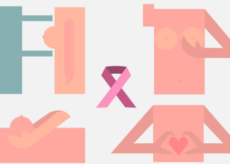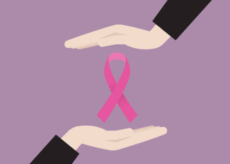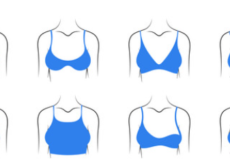Breasts Changes at Age 40, 30, 20 – 9 Visible Changes that Happen
- April 5, 2020
- in Breast Care

As women ages, her body undergoes changes both internally and externally and includes the breasts as well. And it’s a fact that the breast changes a lot as women ages. Skin, hormones, weight gain and loss, etc. affect it much more than one can imagine.
So do you want to know exactly how it changes at each age? Then continue reading….
Age 20
(1) They continue to grow
Did you know that breasts usually continue to grow for at least five years after the first period?
Their firmness is extraordinary and you will notice that they look bigger every time your period approaches. This is because estrogen increases from a few days before and the ducts and breast glands that trap fluid causing them to swell.
Before the breasts develop completely, it is worth investing in moisturizers based on urea, lactic acid and almond oil.
(2) Better looking
Once they’re fully developed, they look better than ever. Between the ages of 20 and 30 they have firm, smooth skin, and unless they are extremely large, they are turgid and look shiny because of the dense tissue that forms them.
Once they’re fully developed, they look better than ever. Between the ages of 20 and 30 they have firm, smooth skin, and unless they are extremely large, they are turgid and look shiny because of the dense tissue that forms them.
In addition, women who become pregnant in their 20s have many changes in their breasts, enlarging them due to weight gain and preparation for breastfeeding. After breastfeeding, breasts may look smaller or larger. Pregnancy can also darken and lengthen your nipples, returning to their normal state, after having the baby.
By the age of 30
(3) Temporary swelling
Hormonal changes, such as the period, substantially influence the size of the breasts, because estrogens increase from a few days earlier, causing the ducts and mammary glands to swell. Pregnancy, breastfeeding or weight changes can also cause them to swell temporarily. If there is no gestation or breastfeeding, the breasts will remain firm.
They still have good elasticity and firmness. However, if you were already a mom the changes in the breasts will be noticeable. The color darkens, maybe they fell slightly or you have stretch marks. Use a cream to moisturize them daily.
Read more: Coconut oil massage for breasts
(4) Size and color of nipples
In addition to the increasing size, pregnancy can also alter the color of the areola and enlarge the nipples. After pregnancy, it should return to its natural color, although in many cases the size does not decrease.
(5) Softness
Once you cross 30, you begin to notice that your breasts feel softer. It can be a sign that you’ve put on a few extra pounds or that you’re starting to age. The dense connective tissue begins to be replaced by breast fat.
At the age of 40
(6) Saggy breasts
After several pregnancies, the skin of the breasts begins to stretch and sag, this is due to the fluctuation in weight and gravity. This can lead to stretch marks or ptosis, which is a significant sagging of the breasts.
Once you start to get close to menopause, your breasts start to sag. Over the years, the skin stretches, causing them to sag and hang down, even if they are not especially large. This happens especially if you go through significant weight changes during and after pregnancy, so don’t be alarmed if they appear.
They begin to lose firmness as the breastfeeding system is reduced and replaced by fat. With the arrival of menopause it is important that at this age more than ever you check them for size, shape, dryness and color.
You may like to read: Using almond oil massage for sagging breasts
(7) They lose volume and the skin loses elasticity
The elasticity of the breasts can go into decline as collagen begins to shrink and they lose density. This is one reason why mastograms are recommended after age 40. This loss of skin elasticity and the thickness of the dermis, allows rigidity, slimming and loosening. In addition, after menopause, women’s estrogen levels decrease, which can cause the breasts to lose volume.
(8) Propensity to skin irritation
The longer they hang, the more likely you are to sweat or develop skin problems from friction. Women with lighter skin may notice that the area becomes dark pink, while the skin darkens even more.
(9) Loss of sensation
The sensations around the nipple come from the nerves inside the breast. As they grow or fall over time, that nerve stretches and sensation may decrease.
Breast Care
When the woman is young, the breast is harder because it has more breast glands and less fat. Besides, the ligaments that support it are also firmer. As time goes by, the mammary glands are being replaced by fat, which is softer, and the breasts gradually become less firm.
For this reason, it is very important to take care of the breast skin by frequent moisturizing it and avoiding hot water bath. The breast skin is covered with a layer of keratin and dead cells that protect it from microorganisms and physical and chemical agents that can attack it. The hot bath destroys this layer, and can cause cracks to appear in the skin. So massaging improves circulation.
Another essential measure to ensure the health and beauty of the breasts is weight management. This is because when women gains fat, either during life or as a result of pregnancy, the breasts increase in size and the skin stretches, often beyond what it can bear. This is where stretch marks appear, which make the breasts collapse.

Author: Nilam

This article has been written by Nilam Mehta and she is one of the owner of this site/blog.
Nilam has worked in Pharmaceutical industry and have studied – Lifestyle Medicine from Doane University; Science of Exercise from University of Colorado Boulder. She believes that many of health problems can be cured naturally.
You can reach her on [email protected]
Medical Disclaimer:
The contents on everydaycares.com, such as text, graphics, images, and other materials care for informational purposes only. The content is not intended to be a substitute for professional medical advice, diagnosis, or treatment. Always seek the advice of your physician or other qualified health provider with any questions you may have regarding a medical condition. Never disregard professional medical advice or delay in seeking it because of something you have read on this website!



